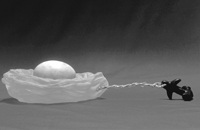Suz has a very interesting story to tell about her journey through art leading to her destination in sculpture. She has been a long-term member of NWSSA and, in addition to producing a substantial body of work, she has also shared her talents through her teaching. Her delightful personality and sense of humor become quite apparent in this interview.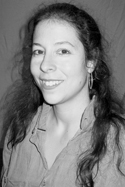
LE: Let’s start by having you tell us about your life history as it relates to becoming an artist.
SG: Both of my parents had an interest in the arts, although they were trained in mathematics and electrical engineering. Eventually this interest led them into antique dealing and restoration, so I was privileged to run my hands over thousands of works of art by the time I was a teenager. I also learned how to lift. I was the little kid on the lower end of those huge 18th century cupboards my mother was enamored with, while my dad guided us and grinned at shocked onlookers. Luckily no one ever did call Social Services, which left me the opportunity to spend time at the Boston Museum of Fine Arts with Harriet Hosmer’s marble work, and a stunning array of Egyptian basalts. We went camping in New Hampshire every summer and literally swam in stone sculpture. The granite bedrock goes on for miles in every direction, and in one stream it is carved into thousands of water falls, and deep, intricate pools, for nearly its entire length. It’s magical. My grandmother would show us the garnets exposed in nearby boulders and we’d use her rock hammer to poke them out.After living for a year in Athens, Greece, I went to Boston University and graduated with a B.S. in Broadcast and Film, which was heavy on writing and research. I wound up in a suit, writing legislation in the State House on Beacon Hill, at one point. Now there’s an image for you. Needless to say, I was minus a few piercings back then. I then did landscape design and installation for several years, until the rocks spoke louder than all the other components combined. I designed and built a historically accurate garden for the federal government at the Salem, Massachusetts Maritime Historic Site. And I still have a soft spot for Bobcats.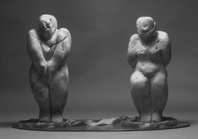
LE: What key life experiences affected your direction in art?
SG: There came a time when it seemed I had run out of options for moving forward in any direction. At this nadir I found myself wandering around our city apartment in a daze, considering the pieces of my life, until I could find one thing that seemed meaningful. I found a piece of soapstone. Never did figure out how it got there-I had never touched soapstone before. I carved it with whatever was in my kitchen. She turned out to be Yemaya, the powerful Yoruban ocean goddess who comes from the West, bringing abundance and healing. My partner, Joel, helped me track down a source for more stone. It arrived on my doorstep, just a naked rock with a stamp on it and my name written in sharpie. I opened the door and nearly tripped over it. It was hilarious.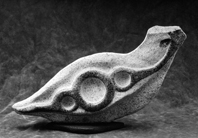
I took off for about six weeks to study in Maryland with Sy Gresser, one of the only stone carvers I could find on the entire east coast. I was ready and willing to drive anywhere for instruction. (I had actually gotten close to finding B. Amore in Boston, but she had just left for Vermont.) The whole experience tested my resolve, which was really good for me. It was also very amusing; every few days Sy would somehow exhume yet another stone from a backyard that was about the size of your average walk-in closet.
After that, I was ready to change everything and leave for the other end of the country. About a month before our move, I went in for a medical checkup, in a last ditch attempt to try to settle some longstanding issues before my insurance would run out. I was blessed to find out I had a brain tumor. I could “wait and see’’ or have it out. I said, “Will tomorrow work for you?” At that moment, I finally got an Attitude. It is of incalculable value to the fairer sex. Because it turned out that literally, I would have not been able to “see” what would happen next. The next thing that would have happened, is that I would have gone blind. And after that, no operation would have been possible at all. So I became very aware of the gifts of sight and of the refusal to be accommodating nd was motivated to use both for making art.
LE: How has NWSSA influenced your work as an artist?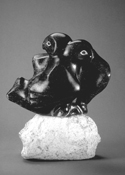
SG: I immediately found NWSSA at the Flower and Garden Show, after moving here, and have participated for the past eleven years. By the time I had unpacked at Camp B for the first time, there were so many spirits vying to come out of the stones, that poor Dennis Joram had no choice but to surrender his angle grinder to me and back away for the duration. The dam had broken. That was the same year I showed up with “Happy Woman.” She made some close friends for me instantly. This affected me profoundly. Later on, I began to teach in order to get more people in contact with this tribe, our tribe.
LE: How do you develop your work?
SG: Since I had been a child, I had done figural art; I have always been fascinated by the human body and the story it tells. That was my starting point in stone as well. Over time, I’ve developed more freedom in choosing imagery and a medium for it. I seem to think in components, as if they were words in a sentence. I enjoy combining stone with encaustic, and sometimes, working with wood, wire, etcetera, in combination with stone, is a good way to get my hands back onto a piece, to be more personal with it. The personal is what is meaningful to me. It is helpful for me to be familiar with several media in order to be sure I am making choices and not decisions.
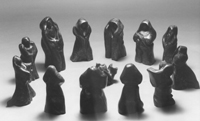
It’s challenging to everybody, I think: that “throwing open the doors” to all possibilities and then contracting/editing/focusing to remove almost everything, everything except that which is the work. Probably everyone develops some kind of practice that keeps the creative process clean. I settle and focus by meditating. Coffee helps in a pinch.
LE: How do you get your ideas?
SG: Sometimes I would like to know how NOT to get them. Ideas, for me, are a perpetual and adorable nuisance. They chatter, they hang from the trees, they keep me up at night, and they can make me a menace to society when I drive. One of these days I hope to work with an assistant. I have at least three works in progress at one time. I nearly always have a notebook within reach, to record anything at all, because words inspire me almost as much as visual imagery. I have this sense that all poetry, all acts of kindness, all music, beauty, and artwork inspire each other, multiplying the total energy as it goes outwards in an open spiral. I have an active dream life and that all goes in there too, along with the drawings. And then those days come along when it is time to strap on the hip waders and go ruthlessly editing through the maelstrom. Previously unrelated life fragments, words and images link up and become art.
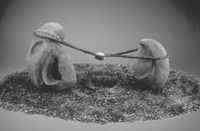
LE: How does your art reflect your philosophy?
SG: I study world religions when I can, and I am moved by those that have direct ties to the earth, from the Orishas of West Africa, to the Dravidian cults of India. Like many others, I work in stone because of my affection for the natural world. I have traveled to several countries, and in my experience, contrary to Disney, the world is quite a big place. I have a fascination for communication, how it happens and how it doesn’t. Languages, from Morse code to Mandarin, are interesting to me. I see that interest pop up sometimes in what I do. Lately, for instance, I seem to have pairs of stones in some kind of conversation with each other. Also, all those years of growing up in love with the lyrical narrative of the handmade object have shaped my basic nature. I love a story. I especially love a story about what it is like to be female. There is much unexplored territory here.
LE: Describe a recent piece or two. What do you like about them?
SG: I’m working on a piece now that will be wall mounted. I like the tension between the two figures as they hang from a pulley. It is also more integrated with the space than I have ever been able to accomplish with anything on a pedestal. I have been looking at ice lately, especially floes, and I’m working on covering a wall with marble in a way that would give a larger perspective of the movement. Usually I am engrossed with detail, wanting to draw someone closer, so this will be an interesting change for me.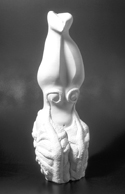
Later on, I would like to head for the ceiling. I have some ideas about carving things that I would not expect to have fallen from the sky. That would be fun. Time to get creative with hardware.
LE: Do you teach?
SG: Yes, I do teach fairly often. Several years ago I came back on fire from Camp B, looked around the Seattle area, and saw no place to learn about stone. I just knew there were more people out there who needed to find stone, so I decided to create places for them. I founded the stone program at Pratt Fine Arts Center in Seattle, and I began the stone classes at Frye Art Museum, also in Seattle. I have cut back my venues to those willing to make the commitment to technical support and program growth. Pratt is an extraordinary place, with a dual mission: classes and artist studio space. We now have a good range of tools available to stone artists, along with space, for $150 a month. Please spread the word; Sabah Al-Dhaher, Kirk McLean, and I would love to have as many carvers over there as we can wedge in. I also do some consulting and private instruction.
LE: Tell me about your process of teaching.
SG: Teaching is more challenging if it consists of personalized “guiding” and it is easier, but perhaps not as useful, if it consists of “telling.” I go for the former approach. And I am wary of the titles involved in the process. I have not met one student yet who has not taught me something valuable. I have been lucky enough to work with some people who are at the top of their game in another skill set. When I see this caliber of person start all over from scratch, and help them enjoy every “mistake,” it is sweet to be reminded of the importance of Beginner’s Mind. Seeing this keeps me on track, personally. Technical skills are fine, and I am crazy about tools and techniques of all kinds, but it is possible to get derailed by the “learning,” out of discomfort at facing up to the “doing.” It seems to me that the practical priority turns out to be the engagement of one’s soul. This is where our energy lies, and we need quite a bit of it to do what we do. Especially if there is a lot of polishing involved!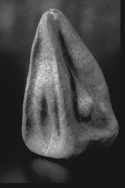
I like to try to bring about a sense of focused play, a kind of flexibility that is peppered with determination to see the thing through. I have worked with people who have actually gotten their MFA degree, and then thrown it away for years because the whole learning process was like going through a Waring blender. Well, life is too short to mistake misery for hard work. The two are not even cousins. I enjoy helping people to short-circuit that critical little troll that pops out every time we get close to the thing that matters.
Stone itself rejects insincere suitors, so those who would continue are, across the board, wonderful individuals, and some of my best friends. I still have it in the back of my mind to help establish a facility capable of large scale work, education, and innovation. This is an idea that has been carried by Ken Barnes, and several others over the years. However, for the next two years, I will be focusing on expanding my own studio and we’ll see what grows from that.
LE: Why did you become an artist?
SG: I used to think that the notion of a “calling” was reserved for a select few in this life, but no longer. There are certain things that the universe wants each one of us to be doing, and this situation will continually present us with successive options to either gain or lose energy. It seems to me that a person can pay a needless price for the bitter privilege of holding onto fear. As I now see it, opportunities will continue to appear and I will be able to live in peace if I keep walking along this twisting path that we call “art.” Besides, I had it coming to me. Two years ago I found out that generations of my father’s family were stonemasons from Tuscany. There you have it.